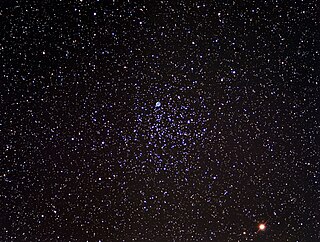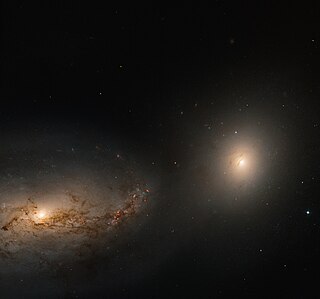Related Research Articles

Galaxy groups and clusters are the largest known gravitationally bound objects to have arisen thus far in the process of cosmic structure formation. They form the densest part of the large-scale structure of the Universe. In models for the gravitational formation of structure with cold dark matter, the smallest structures collapse first and eventually build the largest structures, clusters of galaxies. Clusters are then formed relatively recently between 10 billion years ago and now. Groups and clusters may contain ten to thousands of individual galaxies. The clusters themselves are often associated with larger, non-gravitationally bound, groups called superclusters.

In physics, a redshift is an increase in the wavelength, and corresponding decrease in the frequency and photon energy, of electromagnetic radiation. The opposite change, a decrease in wavelength and increase in frequency and energy, is known as a blueshift, or negative redshift. The terms derive from the colours red and blue which form the extremes of the visible light spectrum. The main causes of electromagnetic redshift in astronomy and cosmology are the relative motions of radiation sources, which give rise to the relativistic Doppler effect, and gravitational potentials, which gravitationally redshift escaping radiation. All sufficiently distant light sources show cosmological redshift corresponding to recession speeds proportional to their distances from Earth, a fact known as Hubble's law that implies the universe is expanding.

In modern physical cosmology, the cosmological principle is the notion that the spatial distribution of matter in the universe is uniformly isotropic and homogeneous when viewed on a large enough scale, since the forces are expected to act equally throughout the universe on a large scale, and should, therefore, produce no observable inequalities in the large-scale structuring over the course of evolution of the matter field that was initially laid down by the Big Bang.

The Great Attractor is a region of gravitational attraction in intergalactic space and the apparent central gravitational point of the Laniakea Supercluster of galaxies that includes the Milky Way galaxy, as well as about 100,000 other galaxies.

A non-standard cosmology is any physical cosmological model of the universe that was, or still is, proposed as an alternative to the then-current standard model of cosmology. The term non-standard is applied to any theory that does not conform to the scientific consensus. Because the term depends on the prevailing consensus, the meaning of the term changes over time. For example, hot dark matter would not have been considered non-standard in 1990, but would have been in 2010. Conversely, a non-zero cosmological constant resulting in an accelerating universe would have been considered non-standard in 1990, but is part of the standard cosmology in 2010.

The Galactic Center is the barycenter of the Milky Way and a corresponding point on the rotational axis of the galaxy. Its central massive object is a supermassive black hole of about 4 million solar masses, which is called Sagittarius A*, a compact radio source which is almost exactly at the galactic rotational center. The Galactic Center is approximately 8 kiloparsecs (26,000 ly) away from Earth in the direction of the constellations Sagittarius, Ophiuchus, and Scorpius, where the Milky Way appears brightest, visually close to the Butterfly Cluster (M6) or the star Shaula, south to the Pipe Nebula.

The Sunyaev–Zeldovich effect is the spectral distortion of the cosmic microwave background (CMB) through inverse Compton scattering by high-energy electrons in galaxy clusters, in which the low-energy CMB photons receive an average energy boost during collision with the high-energy cluster electrons. Observed distortions of the cosmic microwave background spectrum are used to detect the disturbance of density in the universe. Using the Sunyaev–Zeldovich effect, dense clusters of galaxies have been observed.

An intermediate-mass black hole (IMBH) is a class of black hole with mass in the range 102–105 solar masses: significantly higher than stellar black holes but lower than the 105–109 solar mass supermassive black holes. Several IMBH candidate objects have been discovered in the Milky Way galaxy and others nearby, based on indirect gas cloud velocity and accretion disk spectra observations of various evidentiary strength.

Observational cosmology is the study of the structure, the evolution and the origin of the universe through observation, using instruments such as telescopes and cosmic ray detectors.

Messier 46 or M46, also known as NGC 2437, is an open cluster of stars in the slightly southern constellation of Puppis. It was discovered by Charles Messier in 1771. Dreyer described it as "very bright, very rich, very large." It is about 5,000 light-years away. There are an estimated 500 stars in the cluster with a combined mass of 453 M☉, and it is thought to be a mid-range estimate of 251.2 million years old.

In modern models of physical cosmology, a dark matter halo is a basic unit of cosmological structure. It is a hypothetical region that has decoupled from cosmic expansion and contains gravitationally bound matter. A single dark matter halo may contain multiple virialized clumps of dark matter bound together by gravity, known as subhalos. Modern cosmological models, such as ΛCDM, propose that dark matter halos and subhalos may contain galaxies. The dark matter halo of a galaxy envelops the galactic disc and extends well beyond the edge of the visible galaxy. Thought to consist of dark matter, halos have not been observed directly. Their existence is inferred through observations of their effects on the motions of stars and gas in galaxies and gravitational lensing. Dark matter halos play a key role in current models of galaxy formation and evolution. Theories that attempt to explain the nature of dark matter halos with varying degrees of success include cold dark matter (CDM), warm dark matter, and massive compact halo objects (MACHOs).

NGC 3227 is an intermediate spiral galaxy that is interacting with the dwarf elliptical galaxy NGC 3226. The two galaxies are one of several examples of a spiral with a dwarf elliptical companion that are listed in the Atlas of Peculiar Galaxies. Both galaxies may be found in the constellation Leo. It is a member of the NGC 3227 Group of galaxies, which is a member of the Leo II Groups, a series of galaxies and galaxy clusters strung out from the right edge of the Virgo Supercluster.

The Bullet Cluster consists of two colliding clusters of galaxies. Strictly speaking, the name Bullet Cluster refers to the smaller subcluster, moving away from the larger one. It is at a comoving radial distance of 1.141 Gpc.

Abell 520 is a galaxy cluster in the Orion constellation, located at a co-moving radial distance of 811 Mpc (2,645 Mly) and subtends 25 arcminutes on the Earth sky.

Knowledge of the location of Earth has been shaped by 400 years of telescopic observations, and has expanded radically since the start of the 20th century. Initially, Earth was believed to be the center of the Universe, which consisted only of those planets visible with the naked eye and an outlying sphere of fixed stars. After the acceptance of the heliocentric model in the 17th century, observations by William Herschel and others showed that the Sun lay within a vast, disc-shaped galaxy of stars. By the 20th century, observations of spiral nebulae revealed that the Milky Way galaxy was one of billions in an expanding universe, grouped into clusters and superclusters. By the end of the 20th century, the overall structure of the visible universe was becoming clearer, with superclusters forming into a vast web of filaments and voids. Superclusters, filaments and voids are the largest coherent structures in the Universe that we can observe. At still larger scales the Universe becomes homogeneous, meaning that all its parts have on average the same density, composition and structure.

In cosmology, galaxy filaments are the largest known structures in the universe, consisting of walls of galactic superclusters. These massive, thread-like formations can commonly reach 50/h to 80/h Megaparsecs —with the largest found to date being the Hercules-Corona Borealis Great Wall at around 3 gigaparsecs (9.8 Gly) in length—and form the boundaries between voids. Due to the accelerating expansion of the universe, the individual clusters of gravitationally bound galaxies that make up galaxy filaments are moving away from each other at an accelerated rate; in the far future they will dissolve.

In astrophysics, dark flow is a controversial hypothesis to explain certain non-random measurements of peculiar velocity of galaxy clusters. The actual measured velocity is the sum of the velocity predicted by Hubble's Law plus a possible small velocity flowing in a common direction. Very large scale correlated flow, called bulk flow is proposed in this model to be related to certain models of inflationary cosmology.

The Local Sheet in astronomy is a nearby extragalactic region of space where the Milky Way, the members of the Local Group and other galaxies share a similar peculiar velocity. This region lies within a radius of about 7 Mpc (23 Mly), 0.46 Mpc (1.5 Mly) thick, and galaxies beyond that distance show markedly different velocities. The Local Group has only a relatively small peculiar velocity of 66 km⋅s−1 with respect to the Local Sheet. Typical velocity dispersion of galaxies is only 40 km⋅s−1 in the radial direction. Nearly all nearby bright galaxies belong to the Local Sheet. The Local Sheet is part of the Local Volume and is in the Virgo Supercluster. The Local Sheet forms a wall of galaxies delineating one boundary of the Local Void.
References
- ↑ A. Kashlinsky; F. Atrio-Barandela; D. Kocevski & H. Ebeling (2008). "A measurement of large-scale peculiar velocities of clusters of galaxies: results and cosmological implications" (PDF). Astrophys. J. 686 (2): 49–52. arXiv: 0809.3734 . Bibcode:2008ApJ...686L..49K. doi:10.1086/592947. S2CID 16335692 . Retrieved 2010-07-15. Also, A. Kashlinsky; F. Atrio-Barandela; D. Kocevski & H. Ebeling (2009). "A measurement of large-scale peculiar velocities of clusters of galaxies: technical details" (PDF). Astrophys. J. 691 (2): 1479–1493. arXiv: 0809.3733 . Bibcode:2009ApJ...691.1479K. doi:10.1088/0004-637X/691/2/1479. S2CID 11185723 . Retrieved 2010-07-15.